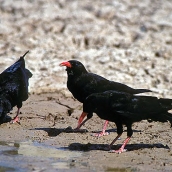Red-billed Chough (Pyrrhocorax pyrrhocorax)
A member of the crow family, measuring 37-41 cm in total length, with a wingspan of 68-80 cm. The plumage is entirely black, the bill is red and curved, and the legs are the same colour. Juveniles, however, have an orangey-yellow bill. Distribution is widespread and comprises the British Isles, southern Europe, parts of the Middle East and Asia, North Africa and the Canary Islands, where it is restricted to La Palma, although isolated birds or pairs have occasionally been reported in La Gomera, Tenerife and Gran Canaria. Subfossil remains have been found in La Gomera, Tenerife and El Hierro, though they are not conclusive in the latter. Evidently the species was widely distributed throughout the archipelago, but disappeared from several islands for reasons unknown. Bone remains have also been identified in paleontological sites of the yellow-billed chough (Pyrrhocorax graculus), currently not represented in the Canaries. The subspecies P. p. barbarus present in the Canaries also lives in Northwest Africa and is known locally as graja, catana or rook. This crag-dwelling bird is closely associated with coastal cliffs, ravines and inland peaks, although it often feeds on gently sloping terrain or flatlands, such as pastures, open pine forests and abandoned cultivated terraces. Its range extends from sea level to the highest peaks of La Palma (2,426 m). Its diet consists of prickly pear (Opuntia spp.) fruit, Canary pine (Pinus canariensis) seeds and others, invertebrates, including the caterpillars of certain moths, and occasionally crustaceans, reptiles and other animals. Its diet is known to vary according to habitat and season. Clutches (4-5 eggs) are generally laid between March and April, although the breeding season starts in February. The nest is located in rocky hollows and crevices, including wayside banks, and more rarely in Canary pines or derelict traditional houses. It tends to breed in small colonies and once the breeding season is over gathers in large flocks (of 200-300 birds or more), which cover large areas. In the Canaries there are around 250-1,000 pairs, but these numbers need verifying. Threats to this species include poaching, habitat alteration and loss, capture of specimens to be kept in captivity, insecticides, changes in land use, a departure from traditional towards intensive farming, and disturbed breeding sites. Compared to the situation outlined in the 1950s, populations appear to be on the increase, thanks to greater environmental awareness and the protection afforded by natural areas, among other factors.













